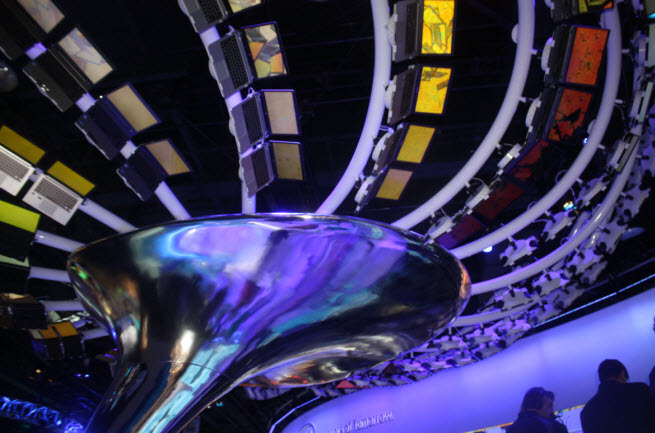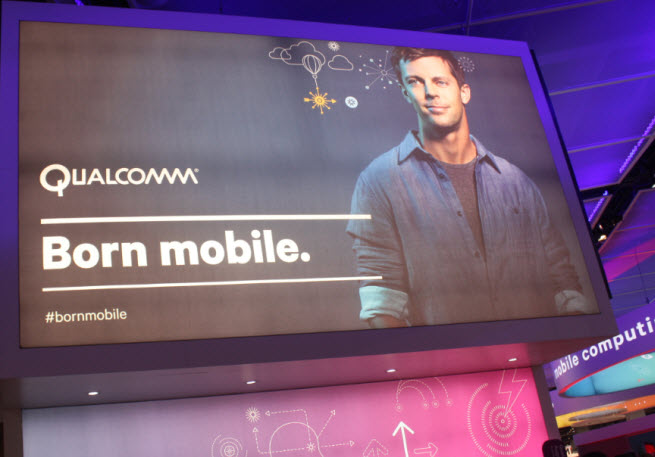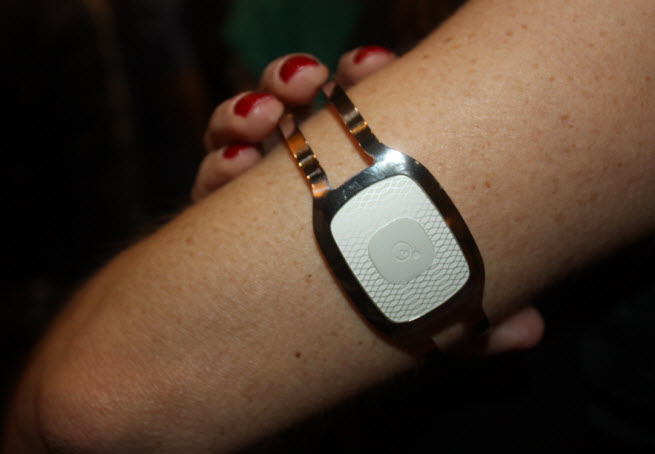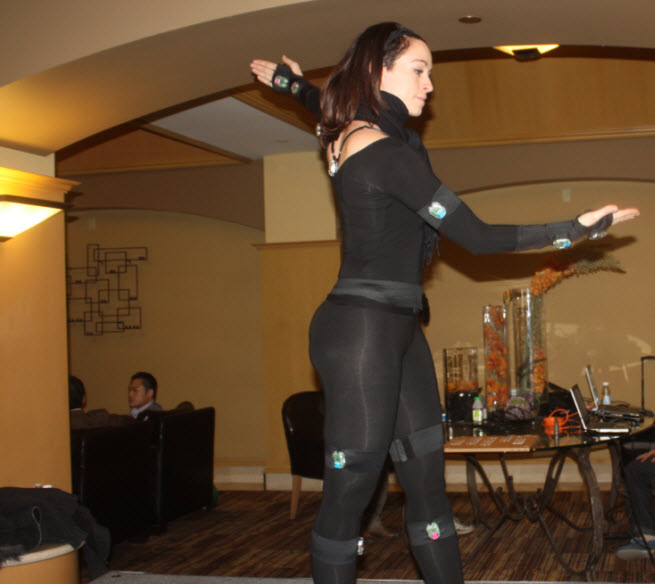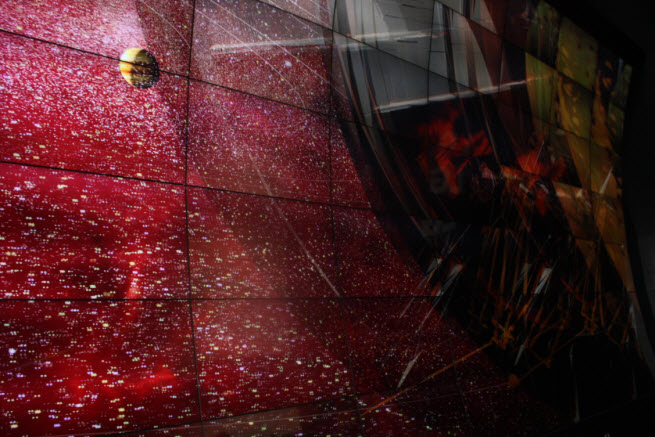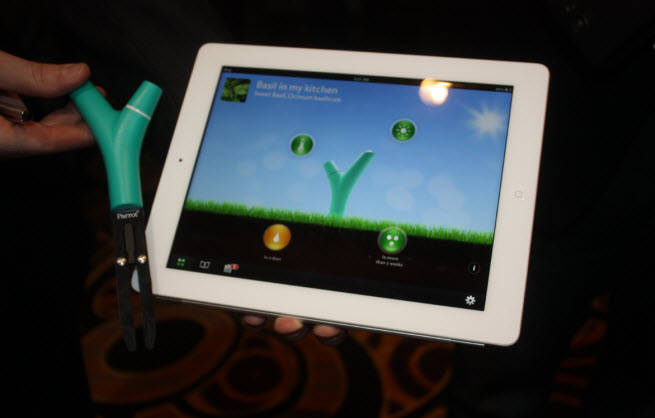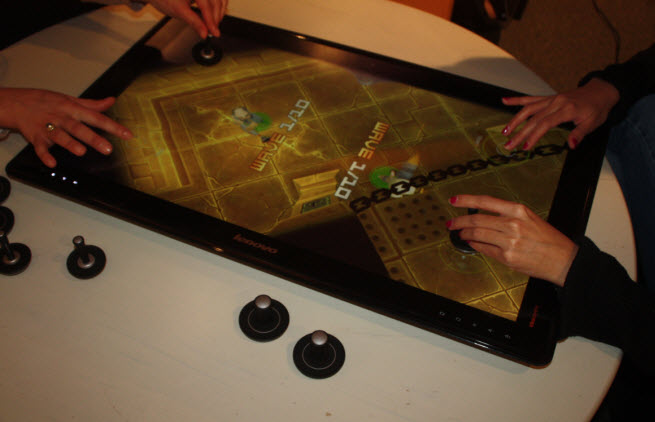If you’re lucky and know where to look, you can see the future in Las Vegas in January. Every year, hundreds of thousands of people clog Las Vegas for an annual orgy of electronic gadgets known as the Consumer Electronics Show. It’s crowded, noisy, and so flooded with TV screens, B-list celebrities, and sparkly cellphone cases that it’s hard to find any real innovation.
But one thing the show is good for is showing the patterns of the tech world over time. A trend begins at one show, and it becomes stronger at the next. Or it fizzles out. This year, LG said more than 70 percent of its TVs connect to the Internet, compared to about 50 percent last year.
You could say that such patterns make CES a cavalcade of copycats who can’t teach you anything. But part of the definition of innovation is building on what others have done before you. CES can help you figure out what’s cool enough to be worth copying. Google’s Project Glass, for example, isn’t a trend yet because nobody is copying the web-connected eyewear, which debuts next year.
If anything, CES gives you perspective on what is working. More than 3,250 exhibitors showed products across a record 1.92 million square feet of exhibits. Looking at those exhibits gives you a glimpse of the future and what should go on sale in the coming months.
We took a couple of stabs at this last year, for CES 2012, once before the show, and once after. We didn’t do so great with a prediction that ultrabooks would breathe new life into laptops. But the two-screen experience materialized in a big way in 2012 as companies linked smartphones, tablets and smart TVs.
And for an even longer perspective, you can go back two years to read our top trends of CES 2011.
Here’s our list of the top 10 trends of CES 2013. Please vote for your favorite in the poll at the bottom.
The mobile generation has become the biggest target audience
When Microsoft CEO Steve Ballmer gave up the opening keynote to Qualcomm CEO Paul Jacobs, it was the changing of the guard. Jacobs had a memorable keynote because it was ridiculed so much, but his theme of “born mobile” was genuine enough. A whole generation of kids are growing up untethered from computers and hooked to their mobile phones instead. They are embracing not just one platform but many. As clumsy and laughable as Qualcomm’s keynote was, it got the basic trend right.
After all, Qualcomm has sold more than 11 billion chips for mobile devices over 27 years. And mobile is leading the way. U.S. homes now have 1.4 tablets per household, compared to 1.2 a year ago. We spend 130 minutes a day with smartphones and tablets, compared to 170 minutes a day watching TV. Expect that to flip. In the U.S., about 44 percent of homes have tablets, up from 1 percent in July 2010. Smartphones are in about 55 percent of homes, compared to 36 percent in July 2010. Jacobs said that 84 percent of people worldwide can’t go a day without using a mobile device. We look at our phones 150 times a day.
Shawn Dubravac, a senior analyst at the Consumer Electronics Association, refers to consumers as “digital omnivores.” This generation isn’t picky. It loves anything tech that works and gets the job done. If you target this mobile market, you have a potential audience of billions, several times larger than the PC audience. This year, larger numbers of companies came to the show knowing that. Next year, they’ll call it the Mobile Consumer Electronics Show. — Dean Takahashi
Fitness and health tech get real
In the cavernous South Hall of the Las Vegas Convention Center, three exhibitor regions were clustered together: the Fitness Tech Zone, the Digital Health Zone, and Gaming. Some companies belonged in all three. The show space in Digital Health was up 25 percent from a year ago.
Last year, the realm of fitness counters was the domain of startups. But bigger companies are getting in on the act. The health insurance giant United Healthcare had a “fitness gaming” exhibit where people played Dance Dance Revolution. Clearly, if people are more fit, the health insurance company’s costs go down. Companies with new offerings in fitness gadgets included Fitbit, Withings, BodyMedia, Basis Science, and Hapilabs (maker of the goofy but intriguing Hapi Fork). They were joined by the likes of Bosch, Nike, and others. HealthSpot introduced an interesting Telehealth Kiosk, which takes your vital signs and then allows you to consult with a doctor via remote consultation.
Ariana Huffington, the creator of the Huffington Post, moderated a session with Reed Tuckson of United Healthcare on “The Human Body: The Next Digital Revolution.” That must be a sign that digital health and fitness tech are revving up a hype cycle that could come crashing down. But we’ll bet that the square footage around these trends will be bigger at next year’s show. My own Striiv step-counting app showed I walked about 31 miles at CES across five days. — Dean Takahashi
The user interface is you
CEA analyst Shawn Dubravac also predicted before the show that gesture and voice will join touch as new ways to control devices. New technologies based on gestures and voice are coming from the likes of General Motors, Texas Instruments, Intel, and Nuance. Those controls will be useful in cars, and it is no accident that there are more car makers than ever coming to CES, Dubravac said.
“Over the next 36 months, we will see fundamental changes in voice control and gestures as well,” Dubravac said.
At Intel’s press event, Tobii showed off its “eye recognition” technology, where it would detect whether you spotted Waldo in a Where’s Waldo puzzle image. Meanwhile, Samsung included voice recognition in its smart TVs. And PrimeSense, the maker of the depth camera technology used in Microsoft’s Kinect (the motion-sensing system for the Xbox 360), demonstrated further uses of 3D sensing technology, including sensing what objects consumers inspect on grocery store shelves. Movea, in a demo pictured above, showed how sensors on a dancer could be translated into an entertaining digital animation in real time.
Intel calls this trend “perceptual computing,” and it wants to mash-up all of the input technologies into computers to improve things such as device security. Microsoft’s slogan for Kinect, “You are the controller,” is looking better every day. — Dean Takahashi
3D glasses are undead
LG had perhaps the prettiest booth with scores of big-screen 3D TVs chained together in a giant screen. And Nvidia had showed off its 3DVision goggles for gaming. But all mention of 3D was curiously absent from the lips of the many executives who touted it in years past. Some companies are still working on glasses-free 3D TVs. But the computing power required to produce a separate image for every viewing angle is a huge obstacle to doing glasses-free 3D right. That computing power is better used producing better images. That’s why 4K Ultra HD TVs were hot this year.
3D was a fad aimed at stopping movie piracy or pumping up the box office receipts. 3D made an appearance as a zombie trend, or something that just won’t die, for a few years. TV makers may include it for free in a last-ditch attempt to keep it alive. But market penetration of 3D TVs topped out at maybe 20 percent or 30 percent. Judging from CES 2013, that market share is going to drop dramatically this year. — Dean Takahashi
Regional changes push China upward
Another changing of the guard is happening across the regions that produce technology. Microsoft surrendered its booth to a Chinese company, Hisense, which is fast becoming one of the major consumer electronics companies of the world. TCL, Changhong, Huawei, Haier, and ZTE had prominent booths at the main hall and the South Hall. China’s Lenovo is already a giant on the world’s stage as the largest maker of PCs on the planet. TCL has acquired the RCA and Thomson brands and unveiled its Blade TV thin model at the show.
No longer are the Chinese relegated to tiny booths in international trade sections of CES. One of these companies might just be the next Samsung, which is only 10 years younger in terms of maturity in the consumer electronics industry. Pretty soon, the Chinese will be taking on the Japanese and the Koreans. — Dean Takahashi
Sensors are making gadgets smarter and bringing forth the internet of things
Smart devices will get smarter because they are connected to sensors, such as accelerometers made by companies such as Invensense, which makes the motion-sensors in popular game consoles such as the Wii.
As devices become more context aware, the label of “smart” will begin to take on new meaning. In the past, it simply meant that a device, such as a smartphone or Smart TV, was connected to the Internet. Soon, it will mean that the device will know much more about what is relevant to you because it knows your context, location, and tastes. Motion-sensing accelerometers are embedded in everything — things like the Wii U game console and the Hapi Fork from Hapilabs. But new sensors such as eye-trackers have made their way into experimental TVs from Haier. Parrot had a new take on plant sensors (pictured), which detect the dryness of a plant’s soil and tell you when it needs water.
Dubravac is looking forward to smart windows, transparent monitors such as one made by Samsung last year, and smart watches. And then we’ll move on to the reality of the “Internet of things,” where low-cost sensors and online connectivity are in just about everything. When next year’s Android devices and iPhones come out, you can expect that they will have more sensors and hubs to manage them. — Dean Takahashi
Alternatives to console gaming multiply
Forget the Nintendo Wii U and the upcoming consoles from Microsoft and Sony. CES was full of alternatives to console gaming. Lenovo created its 27-inch Table PC to bring back family game night. Nvidia introduced its Tegra 4-powered Project Shield, a mobile gaming device that can play games via Android, Nvidia’s Tegra Zone, Valve’s Steam service, and, presumably, cloud gaming services. Valve, meanwhile, threw its weight behind Xi3’s Piston modular computer, which could be the basis for Valve’s Linux-based open gaming machine, the so-called Steam Box.
PowerA introduced a Moga Pro controller to play Android games on smartphones and tablets with a traditional game controller. The Oculus Rift showed off a new virtual reality gaming system that won’t make you sick. Razer introduced the Razer Edge, a Windows 8 tablet with handles that have traditional game controls. And Sifteo showed off a new version of its smart blocks, which you can put together and use to play games.
These systems exist because the console makers have been slow to introduce new versions and they have yet to embrace cloud gaming and free-to-play games. — Dean Takahashi
Car technologies go big
With more than 100,000 square feet dedicated to car technologies this year, CES is increasingly becoming an auto tech show. With even more force than last year, companies including Lexus, Audi, Ford, and Chevrolet all showed off new models of cars and talked about tech they could incorporate in the future.
The most impressive thing we saw on the floor on car tech had to be Lexus’ semi-autonomous car. While Google has pushed its own driverless-car technology, Lexus seems to be pushing for an experience where the car can be an “intelligent co-pilot,” rather than drive itself around. While it doesn’t expect a semi-autonomous car to land in the near future, a Lexus exec did tell us the driverless car research is helping develop new features like better lane-keep-assist on future cars.
Audi did not show its driverless car on the CES show floor, but the German car maker did talk about it a bit during the show. It has developed a quite cool program that lets a car park itself. Audi believes the self-parking car could be here before the end of this decade.
Ford took a big step toward getting more mobile apps interacting with its cars with the Ford Developer Program. Ford has one million cars on the road in the U.S. that feature its AppLink program that lets users interact with iOS and Android apps by using their voice. Additionally, Ford added Amazon, Rhapsody, the Wall Street Journal, and more as new AppLink partners so drivers can do more with apps while on the road.
We can’t wait to see what other car tech breakthroughs appear throughout 2013. — Sean Ludwig

UltraHD 4K TVs come into focus
Just when you thought TVs couldn’t get any more confusing, along comes a wide array of new UltraHD (also known as 4K) sets. The new format offers around four times the resolution of 1080p, the highest resolution of HDTVs so far. We’ve heard about the potential of 4K for some time now — it’s also made its way into cinemas and home projectors over the past few years — but this year was the first time just about every TV manufacturer had a 4K set to show at CES.
Samsung introduced a whopping 110-inch 4K set, and Sony has new 55-inch and 64-inch sets coming (joining its 84-inch behemoth).
While magnificently large and clear, we’re still unimpressed with the state of 4K so far. The TV’s are incredibly expensive, clocking in above $10,000 for 55-inch sets (in the rare cases companies discussed prices), and the 4K content ecosystem is nowhere to be seen. The new format’s films are too large for Blu-ray discs, which means we’ll either need a whole new disc format or a massive leap in streaming video efficiency and quality. So far, the 4K camera maker Red’s $5,000 “Redray” streaming offering is the closest we have to bringing 4K content to your home.
Ultimately, 4K’s impracticality makes it a pipe dream for most living rooms. At typical viewing distances, most consumers likely won’t even see the benefits until screen sizes climb above 80 inches. But of course, CES isn’t about showing us what’s immediately practical. With so many 4K sets announced this year, it’s clear that the pieces are finally being put in place for 4K’s promise to come into a reality.
For now, if you really want to get ready for the 4K revolution, consider investing in a 4K-capable home projector. You’ll get some immediate benefits by upscaling existing HD content, and you’ll likely save tens of thousands (not to mention time spent waiting) over huge 4K TV sets. — Devindra Hardawar

Components become the star of the show (again)
This CES was strangely lacking in major device announcements. Most companies are saving their phone and tablet announcements for Mobile World Congress next month, and others will likely hold their own press events throughout the year. That left the door wide open for component makers like Qualcomm, Intel, Advanced Micro Devices, and Nvidia to hog the spotlight. All unveiled major chips at the show.
Nvidia announced the Tegra 4, its latest mobile processor sporting 72 graphics cores, while Qualcomm debuted its next Snapdragon chips, the Snapdragon 600 and 800. With the new mobile chips, both companies are setting the stage for the next mobile processor wars, which will directly impact the smartphones and tablets on the horizon. Both companies also held the biggest events of the show: Nvidia held a massive press conference to announce the Tegra 4 and Project Shield, while Qualcomm’s Paul Jacobs replaced Microsoft’s Steve Ballmer as the opening keynote speaker. Intel unveiled faster Ultrabook chips and AMD touted both graphics chips and faster processors.
Corning also announced the third version of its Gorilla Glass for mobile devices, which promises to be even stronger and more scratch resistant than its past versions. For a company like Corning, CES may be the only place that it can show its next-generation of super strong glass. Sharp also went on about its “IGZO” gallium arsenide zinc oxide technology that makes TV displays better when it comes to power consumption.
As a trade show, CES is typically where component makers of all types and sizes come to pitch their wares. So ultimately, the increased attention for components is more of a return to form for the show, back to a world before the rise of mobile made us expect something dramatically new every year. — Devindra Hardawar and Dean Takahashi
VentureBeat's mission is to be a digital town square for technical decision-makers to gain knowledge about transformative enterprise technology and transact. Learn More
